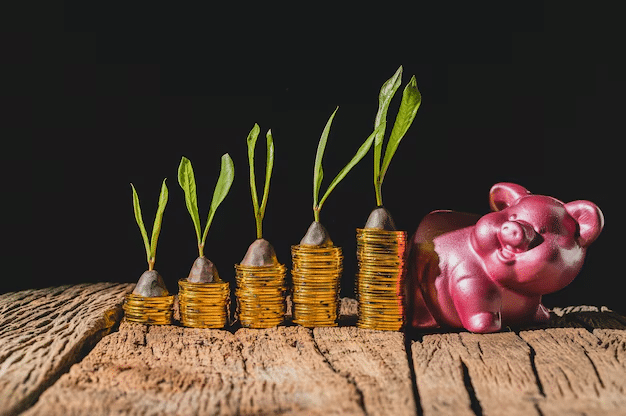Compound interest is often described as “interest on interest,” and it is one of the most powerful concepts in finance. It is the process where interest is calculated on both the initial principal (the original amount of money) and the accumulated interest from previous periods. Over time, compound interest can significantly increase the value of an investment, making your money grow faster compared to simple interest, which is only calculated on the principal.
Let’s break down how compound interest works and why it’s an essential concept for anyone looking to grow their wealth.
1. Understanding Compound Interest

In simple terms, compound interest occurs when the interest earned on an investment or loan is added to the principal, and then the interest is calculated on the new total. This means that each time interest is added to your balance, it’s calculated based on a higher amount. The more frequently interest is compounded, the faster your money will grow.
Formula for Compound Interest:
The formula for calculating compound interest is:
A = P (1 + r/n) ^ nt
Where:
- A is the amount of money accumulated after interest.
- P is the principal amount (the initial investment).
- r is the annual interest rate (in decimal form).
- n is the number of times interest is compounded per year.
- t is the time the money is invested or borrowed for, in years.
2. How Compound Interest Works
Imagine you invest $1,000 at an annual interest rate of 5%, and the interest is compounded yearly. After one year, you would earn $50 in interest (5% of $1,000). In the second year, you earn interest on both the original $1,000 and the $50 interest from the first year. This means you will earn $52.50 in the second year ($1,050 × 5%).
Over time, this process accelerates because the interest compounds, increasing the amount of interest earned as the principal grows.
3. Why Compound Interest Makes Your Money Grow
Compound interest accelerates the growth of your investments over time because it builds upon itself. The more frequently the interest is compounded, the faster your money grows. For example, if interest is compounded monthly rather than annually, your money grows even faster because the interest is being calculated and added to your balance 12 times a year instead of once.
The Power of Time:
The biggest advantage of compound interest is the longer you leave your money to grow, the more significant the effect. For example, an investment of $1,000 at a 5% annual interest rate will grow to $1,628.89 in 10 years. If you leave it for 20 years, the same investment grows to $2,653.30. The effect of compounding becomes more pronounced as time goes on.
Example of Compound Interest:
Let’s say you invest $10,000 in an account with a 6% annual interest rate, compounded annually, for 5 years. Here’s how it would grow:
- Principal (P): $10,000
- Rate (r): 6% or 0.06
- Time (t): 5 years
- Compounds per year (n): 1
Using the compound interest formula:
A = 10,000 (1 + 0.06/1) ^ (1 × 5)
A = 10,000 (1.06) ^ 5
A = 10,000 × 1.3382
A = $13,382.20
At the end of 5 years, your $10,000 investment would grow to $13,382.20, earning $3,382.20 in compound interest.
4. Types of Compound Interest
- Daily Compounding: Interest is compounded daily, and this results in the fastest growth of your money. Many savings accounts and credit cards use daily compounding.
- Monthly Compounding: Interest is compounded monthly, and while slower than daily compounding, it still accelerates growth.
- Quarterly and Annually Compounding: Interest is compounded quarterly or annually, which means less frequent additions of interest to the principal and slower growth.
The more frequently interest is compounded, the more it will add up over time. For example, a savings account that compounds interest daily will grow faster than one that compounds interest yearly.
5. Real-Life Applications of Compound Interest
Retirement Accounts (401(k), IRA):
Long-term retirement accounts benefit significantly from compound interest because they have many years to grow. The earlier you start contributing, the more time your investments have to compound.
Savings Accounts:
Savings accounts with compound interest allow you to earn money on your deposited funds. The more frequently the interest compounds, the faster your balance will grow.
Investment Accounts (Stocks, Bonds, Mutual Funds):
Investments such as stocks or bonds with reinvested dividends use compound interest to help your money grow. This is why long-term investors often see significant gains over time.
6. Risks of Compound Interest
While compound interest can work in your favor as an investor, it can also work against you if you’re on the borrowing side. For example, credit card debt compounds daily or monthly, meaning interest accumulates quickly and can lead to growing balances if not managed carefully.
It’s essential to be mindful of how compound interest affects loans, as it can make outstanding debts grow faster than anticipated, especially if the interest rate is high.
Conclusion
Compound interest is a powerful financial concept that can turn even modest investments into significant sums over time. By allowing interest to accumulate on both the principal and the interest already earned, compound interest accelerates the growth of your money. Whether you’re saving for retirement, investing in a high-yield savings account, or purchasing bonds, understanding how compound interest works can help you make smarter financial decisions and maximize your returns.
FAQs
What is compound interest in simple terms?
Compound interest is the interest on a loan or deposit that is calculated based on both the initial principal and the accumulated interest from previous periods.
How does compound interest help your money grow?
Compound interest helps your money grow faster because the interest is calculated on both the original amount and the interest that has been added over time.
What is the difference between simple interest and compound interest?
With simple interest, you earn or pay interest only on the original principal amount. With compound interest, interest is calculated on both the principal and the accumulated interest, leading to faster growth.
Can I calculate compound interest on my own?
Yes, you can use the compound interest formula to calculate it manually, or use an online compound interest calculator to make the process quicker.
How often is compound interest applied?
Compound interest can be applied daily, monthly, quarterly, or annually, and the more frequently it’s compounded, the faster your investment will grow.
Is compound interest good for savings?
Yes, compound interest is beneficial for savings because it allows your money to grow steadily over time, especially with long-term investments or accounts.


